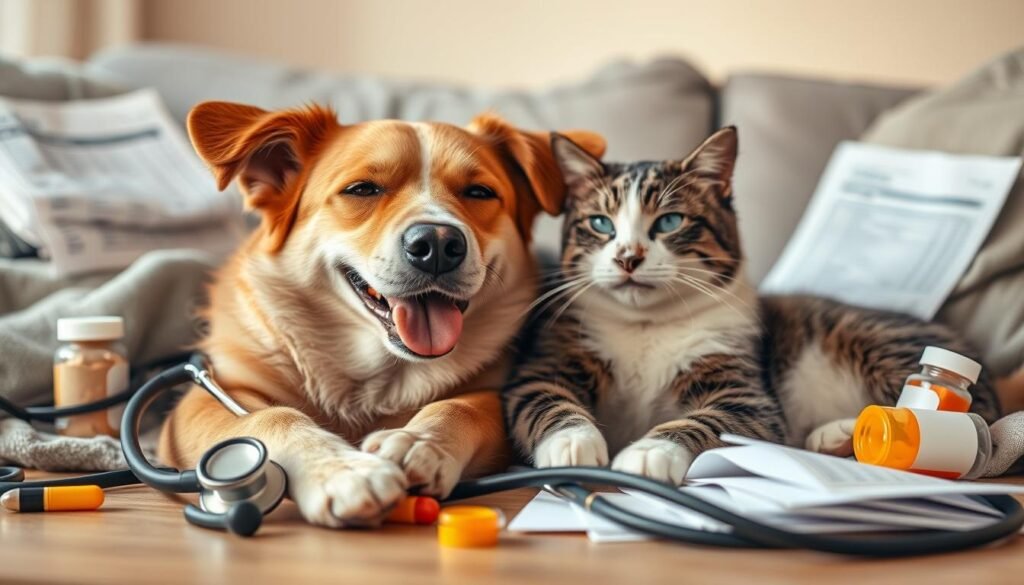Did you know that about 50% of dogs over 10 years old get cancer? It’s a big reason why they die. Treating cancer can cost over $10,000 for several visits1. As pet owners, we want the best for our pets, but it’s expensive. That’s why pet insurance for cancer is so important.
With pet insurance, you can get your pet the cancer treatments they need without breaking the bank. It can cover some of the costs for treatments, meds, and exams. This makes it easier for pet owners to afford care2.
Key Takeaways
- Cancer is a leading cause of death in pets, with around 50% of dogs over 10 developing the disease.
- Veterinary cancer treatments can easily exceed $10,000, creating a significant financial burden for pet owners.
- Pet insurance can help reimburse a portion of the costs for cancer-related treatments, procedures, and medications.
- Enrolling in pet insurance early can provide complete coverage and help manage the costs of unexpected illnesses like cancer.
- Certain pet insurance plans offer discounts for military members, service dogs, and multiple pets, making coverage more accessible.
The Cruel Reality of Pet Cancer
Staggering Statistics on Pet Cancer Rates
Cancer is a major killer of pets, with about 50% of dogs over 10 years old getting it3. Cats also get cancer, like lymphoma, with 8% of Embrace’s insured cats getting it, costing around $2,900 on average4. The cost of pet cancer care has risen over 60% in the last decade3.
Common Signs and Symptoms to Watch For
Look out for signs like trouble eating or breathing, lumps, swelling, pain, and sudden weight changes3. Regular vet visits can catch cancer early, when treatment works better.
| Cancer Type | Percentage of Insured Pets Affected | Average Cost of Treatment Without Insurance |
|---|---|---|
| Lymphoma (Cats) | 8% | $2,900 |
| Cruciate Ligament Injuries (Dogs) | 17% | $4,500 |
Veterinary care is getting better, with more treatments like physical therapy and chemotherapy5. But, this makes costs go up fast. This has led to big companies buying up vet clinics, like in healthcare3.
Why Pet Insurance for Cancer Treatment is Essential
Pet insurance for cancer treatment is vital for your pet’s health. Cancer is a serious illness, and the costs can be too high without insurance6.
Pet insurance covers many cancer-related expenses. This includes tests, imaging, chemotherapy, and surgeries. It lets pet owners focus on their pet’s health, not the bills7.
Pet insurance for cancer has many benefits. It helps with the financial stress and ensures pets get the best treatments. The cost of cancer treatment can be $3,800 for cats and $4,100 for dogs6.
- Pet insurance covers important tests like biopsies and scans for early detection6.
- It also covers chemotherapy, radiation, and targeted therapies for cancer management6.
- Surgeries, like tumor removal, are often included in the coverage6.
Getting pet insurance means your pet gets the best care without financial worries. Cancer treatment is long and tough, but insurance helps7.
Pet insurance for cancer is not just a luxury; it’s a must for pet owners. With the right insurance, your pet gets the treatment they need for a full recovery7.
Understanding Pet Insurance Coverage for Cancer
Dealing with pet insurance can be tough, even more so with cancer. But, with the right info, you can find a policy that protects your pet8.
What Cancer Treatments are Typically Covered?
Most good pet insurance plans cover many cancer costs. This includes tests, chemo, radiation, surgery, and even special treatments like immunotherapy8. Fetch Pet Insurance, for example, pays up to 90% for cancer care from vets8.
Pre-Existing Condition Clauses and Waiting Periods
But, watch out for rules on pre-existing conditions and waiting times. These might not cover cancer found before you got the policy9. It’s key to look at different plans to find the right one for your pet8.
Spot Pet Insurance lets you tailor your coverage. You can choose unlimited annual limits and get up to 90% back for vet bills9. They also offer extra coverage for regular check-ups and dental care9.
Knowing how pet insurance works for cancer helps you protect your pet. This way, they get the best care when they need it most8910.
pet insurance cancer and Treatment Options
Dealing with pet cancer can be tough, but pet insurance helps a lot. Good pet insurance covers many cancer treatments for dogs and cats. It also helps with many illnesses11. But, it won’t cover cancer that starts before you buy the policy11.
Chemotherapy and Radiation for Pets
Pets can get cancer treatments like chemotherapy and radiation. Chemotherapy helps with pain and comfort, not just fighting cancer11. Radiation, like CyberKnife™, targets cancer spots well with fewer side effects11.
Surgical Interventions and Targeted Therapies
There are also surgeries and special treatments for pet cancer11. These options can really help pets with cancer live better lives.

Pet insurance can really help when your pet has cancer. Knowing about treatments and insurance can help you make the best choices for your pet11.
“Our pets are more than just companions – they are family members. When they face the challenge of cancer, having the right insurance coverage can make all the difference in their quality of life and our ability to provide them with the care they deserve.”
It’s key to sign up for pet insurance early. Most plans don’t cover cancer that starts before you sign up12. This way, your pet can get the care they need if they get cancer.
The Financial Burden of Pet Cancer Treatment
Pet cancer treatment can be very expensive. The average vet visit for cancer care costs about $725 for dogs and $605 for cats13. Procedures like chemotherapy, radiation, and surgery can cost hundreds to thousands of dollars14. This makes pet insurance very important to help cover these costs without financial worry.
Average Costs for Common Procedures
Pet cancer treatment can be very costly, with prices ranging from thousands to tens of thousands of dollars13. Here are some common procedures and their average costs:
- Chemotherapy: $150 to $600 per dose, with full treatment series costing $3,000 to $10,00014.
- Radiation therapy: $4,500 to $6,00014.
- Surgery: $500 to $5,00014.
- Bone marrow transplants: Starting at about $13,00014.
- Palliative care: $1,000 to $1,80014.
- Acupuncture sessions: $65 to $120 per session14.
- CyberKnife™ Radiosurgery: Up to $10,000 for 15-20 radiation sessions14.
These costs can quickly add up. That’s why pet insurance is a smart choice to help cover these expenses13. Companies like Lemonade and Trupanion offer good coverage for cancer treatment, including tests, procedures, and meds13.
“Healthy Paws Pet Insurance covered over $18,000 for a dog named Baxter’s treatment.”14
How Pet Insurance Eases the Financial Strain
Pet insurance can change the game for pet owners facing cancer treatment costs. It offers up to 90% reimbursement for vet bills, including tests, treatments, and hospital stays15. This lets owners focus on their pet’s health, not the bills.
Over 5.6 million dogs and cats in the U.S. had insurance in 2023, a 17% jump from 202215. The number of insured pets has doubled from 2019, showing the industry’s growth15. With policies costing about $676 for dogs and $383 for cats yearly, it’s a smart way to protect your pet15.
Pet insurance also covers costs for care like grief counseling and euthanasia15. This helps during tough times, giving you peace of mind and financial relief.
| Policy Type | Average Annual Cost for Dogs | Average Annual Cost for Cats |
|---|---|---|
| Accident and Illness | $676 | $383 |
| Accident-Only | $204 | $116 |
Pet insurance is a smart choice for any pet, young or old16. It shields your pet from cancer treatment costs, ensuring they get the best care without hurting your wallet.

Pet Cancer Success Stories with Insurance
Real-life pet cancer success stories show how pet insurance can save lives. Dug, a six-year-old dog, got chemotherapy for lymphoma. Esme, a three-year-old Miniature Australian Shepherd, had a tumor removed and got radiation therapy. Misty, a senior Chinchilla Persian cat, had surgery for kidney cancer. These cases highlight how pet insurance cancer claims can lead to recovery, not heartbreak17.
Jasper’s story is truly inspiring. He was first diagnosed with oral papilloma virus, then squamous cell carcinoma. His owners traveled far to find the right treatment at UC Davis Veterinary Medicine clinic. Jasper had a mandibulectomy and joined a clinical trial. After a new growth, he got five days of radiation therapy, which worked. His owners were thankful for pet insurance, which covered $19,953 of Jasper’s $25,566 treatment17.
Wilbur, insured with Southern Cross, had a scary health scare. An abdominal ultrasound showed a tumor, but surgery was successful. His GoldRibbon PetCare plan covered 80% of the cost, with a 20% co-payment. His owner, Carol, says pet insurance is vital as pets age and face health issues. Without it, Wilbur’s treatment would have been too expensive18.
Nutmeg, a Labrador retriever, was a top agility competitor in 2020. She had a mass in her intestine area, needing surgery. Healthy Paws pet insurance covered $9,455 of the $14,219 cost. Nutmeg also had chemotherapy, and her future was uncertain. Her owner credits pet insurance for Nutmeg’s extra two months of life19.
These real-life pet cancer treatment stories show the importance of pet insurance. It provides the resources and support needed for cancer treatment. By sharing these stories, we hope to encourage more pet owners to get pet insurance coverage. This way, their pets can get the care they need.
Choosing the Right Pet Insurance Plan
Protecting your furry friend from cancer treatment costs is key. It’s important to pick the right pet insurance plan. Look at several factors to make sure your pet gets the coverage they need20.
Factors to Consider When Comparing Policies
First, check the cancer coverage level. Choose plans that offer high reimbursement rates, like Figo Pet Insurance’s 100% coverage after the deductible20. Also, avoid plans with annual or lifetime caps, as they can limit support for your pet’s treatment.
Next, consider the waiting period before coverage starts. Some plans, like Embrace Pet Insurance, have a six-month wait for cancer-related expenses20. Enrolling early is best to avoid exclusions for pre-existing conditions.
Also, look at the range of cancer treatments covered. ASPCA Pet Health Insurance’s Complete Coverage plan includes many options for your pet’s needs20.
Lastly, think about the monthly costs and any deductibles or co-payments. While more expensive plans may offer better coverage, finding a balance is key. This ensures you can give your pet the care they need21.
| Key Factors to Consider | Details |
|---|---|
| Reimbursement Rate | Look for policies with high reimbursement rates, up to 90% or even 100% after the deductible is met. |
| Annual/Lifetime Limits | Avoid plans with caps on the amount they will reimburse annually or over your pet’s lifetime. |
| Waiting Periods | Consider the waiting period before coverage for cancer-related expenses kicks in, with some plans having a six-month waiting period. |
| Breadth of Coverage | Ensure the plan covers a wide range of cancer treatments, including alternative therapies. |
| Premiums and Deductibles | Balance the cost of the plan with the level of coverage to find the best fit for your budget. |
By carefully evaluating these factors when choosing pet insurance for cancer, you can find a plan that provides the best coverage for your pet’s needs and your financial situation22.

Early Enrollment: The Key to Comprehensive Coverage
Getting your pet insured early is key for the best coverage, like for early pet insurance for cancer. If your pet gets cancer before you get insurance, it might not be covered23. Early insurance helps protect your pet’s health and saves money on cancer treatments24.
About 25% of dogs will get cancer, with risks going up after age 1024. Every year, 6 million dogs in the U.S. get cancer24. Some breeds, like Golden Retrievers, are more likely to get cancer24. Cats also get cancer, with lymphoma being common24.
Thanks to better treatments, many pets with cancer can live longer24. But, treatments can be very expensive. Pet insurance helps by covering many cancer treatments24.
Enrolling in pet insurance early means your pet gets the best care23. It helps with the cost of cancer treatments and lets you focus on your pet’s health23.
If your pet gets cancer, pet insurance can be a big help23. It gives you peace of mind and lets you focus on your pet’s recovery23. Don’t wait – get pet insurance for your pet today23.
Breed Predispositions and Risk Factors for Pet Cancer
Some dog and cat breeds are more likely to get cancer. Big dog breeds like golden retrievers and Bernese mountain dogs are at higher risk25. Siamese and Himalayan cats are more likely to get lymphoma25.
Other things can also affect a pet’s cancer risk. Secondhand smoke and spaying/neutering are important factors25. Talking to your vet can help you keep your pet healthy and catch problems early.
Purebred dogs are more likely to get cancer and need health insurance than mixed-breed dogs25. Smaller dogs are less likely to get cancer than bigger ones25.
Some breeds are more at risk for certain cancers. For example, Pekingese/Poodle mixes are more likely to get melanoma25. Airedale Terriers, Beagles, and Schnauzers are also at risk25. But Pomeranians, Chihuahuas, and French Bulldogs have a lower risk of cancer25.
Knowing about these risks can help keep your pet safe. Regular vet visits, early detection, and the right insurance are key. They help keep your pet healthy and happy for a long time.

Preventive Care and Early Detection Strategies
Keeping your pet healthy is key. Regular vet visits are essential. Your vet can check your pet’s health, run tests, and watch for any problems26.
Spaying or neutering, vaccinations, a good diet, and exercise can lower health risks. Microchipping is also important for finding lost pets26.
It’s important to protect your pet from fleas, ticks, and heartworms. These pests can spread diseases. Monthly treatments are recommended26.
Pet insurance with Preventive Care add-ons can help with vet visits and care27. This care can lead to early cancer detection and treatment28.
| Preventive Care Measure | Benefits |
|---|---|
| Spaying or Neutering | Decreases health risks like common cancers in female dogs and prostate or testicular cancer in male dogs26 |
| Core Vaccinations | Protects dogs from contagious diseases affecting the nervous system and causing respiratory infections26 |
| Balanced Diet | Supports overall wellness and dental health26 |
| Regular Exercise | Maintains energy, health, and weight26 |
| Microchipping | Helps identify and reunite lost pets with their owners26 |
| Parasite Prevention | Protects against dangerous diseases transmitted by fleas, ticks, and mosquitoes26 |
| Annual Vet Checkups | Allow for monitoring overall health, weight, and preventive testing26 |
By focusing on preventive care and vet visits, you can protect your pet’s health. This increases the chance of finding cancer early28. With the right care, your pet can live a long, happy life26.
Conclusion
Pet insurance for pet insurance cancer coverage is a must for pet owners. It helps cover the high costs of pet cancer treatment. This way, your pet can get the care they need to fight this serious disease29.
Knowing what your insurance covers and comparing plans is key. Enrolling your pet early helps avoid financial stress. The importance of pet insurance for cancer is huge. Cancer is a big killer for dogs and cats in many countries29.
Studies show that good pet insurance leads to more vet visits and spending. So, getting a good pet insurance plan is vital. It ensures your pet gets the best care without breaking the bank30.
FAQ
What is the importance of pet insurance for cancer coverage?
What types of cancer treatments are typically covered by pet insurance?
How do pre-existing condition clauses and waiting periods impact pet insurance coverage for cancer?
What are the average costs associated with pet cancer treatment?
How can pet insurance help with the financial burden of cancer treatment?
What are some real-life success stories of pets battling cancer with the help of pet insurance?
What factors should pet owners consider when choosing a pet insurance plan for cancer coverage?
Why is it important to enroll your pet in a pet insurance plan as early as possible?
What breed-specific and risk factors can increase a pet’s chances of developing cancer?
How can regular veterinary check-ups and preventive care help with the early detection of cancer in pets?
Source Links
- Does Pet Insurance Cover Cancer? | MetLife Pet Insurance – https://www.metlifepetinsurance.com/blog/pet-insurance/cancer/
- Pet Cancer and Treatment – https://www.healthypawspetinsurance.com/cancer-coverage-for-pets
- Why You’re Paying Your Veterinarian So Much – https://www.nytimes.com/2024/06/23/health/pets-veterinary-bills.html
- Should you buy pet insurance? Most policies are a bad buy long-term – https://www.startribune.com/should-you-buy-pet-insurance-most-policies-are-a-bad-buy-long-term/600161353
- Is Pet Insurance Worth it? – https://qz.com/advisor/pet-insurance/is-pet-insurance-worth-it/
- What Pet Insurance Covers Cancer Treatment? – https://www.forbes.com/advisor/pet-insurance/pet-care/cancer-treatment-coverage/
- Can Pet Insurance Help Fight Pet Cancer? | PetCure Oncology – https://petcureoncology.com/can-pet-insurance-help-fight-pet-cancer/
- Does Pet Insurance Cover Cancer | Fetch Pet Insurance – https://www.fetchpet.com/pet-insurance-coverage/cancer
- Will Pet Insurance Cover Cancer? Coverage Options | Spot® – https://spotpet.com/blog/why-pet-insurance/does-pet-insurance-cover-cancer
- Cancer Coverage & Pet Insurance | The Motley Fool – https://www.fool.com/the-ascent/insurance/pet/petcancer-coverage/
- Does Pet Insurance Cover Cancer? – https://www.progressive.com/answers/does-pet-insurance-cover-cancer/
- Does Pet Insurance Cover Cancer Treatment? – https://www.marketwatch.com/guides/pet-insurance/does-pet-insurance-cover-cancer/
- How Pet Insurance Can Ease the Financial Burden of Cancer Treatment – https://blog.fidocure.com/fidocure-blog/how-pet-insurance-can-ease-the-financial-burden-of-cancer-treatment
- Understanding the Average Cost of Cancer Treatment for Your Pet | Healthy Paws Pet Insurance – https://www.healthypawspetinsurance.com/blog/cost-of-cancer-treatment-for-your-pet
- Is Pet Insurance Worth It? 2024 Guide – NerdWallet – https://www.nerdwallet.com/article/insurance/is-pet-insurance-worth-it
- Is Pet Insurance Worth The Cost? | Bankrate – https://www.bankrate.com/insurance/pet-insurance/is-pet-insurance-worth-it/
- Pet Parent Goes to Extreme Measures to Save Cancer-Stricken Dog | Healthy Paws Pet Insurance – https://www.healthypawspetinsurance.com/blog/pet-parent-goes-to-extreme-measures-to-save-cancer-stricken-dog
- Wilbur’s dog story | Southern Cross Pet Insurance – https://www.southerncrosspet.co.nz/pet-hub/real-stories/wilburs-story
- Pet Insurance Story: Insurance Gives Nutmeg a Little More Time | Healthy Paws Pet Insurance – https://blog.healthypawspetinsurance.com/pet-insurance-story-nutmeg-the-lab-survives-cancerous-tumor
- How to Compare Pet Insurance Plans & Find The Best Fit – https://www.pawlicy.com/blog/pet-insurance-comparison/
- 7 Financial Benefits of Pet Insurance | MetLife – https://www.metlife.com/stories/personal-finance/reasons-why-having-pet-insurance-can-make-your-life-easier/
- What Medical Expenses Does Pet Insurance Cover For Your Pet? | Bankrate – https://www.bankrate.com/insurance/pet-insurance/what-medical-expenses-pet-insurance-covers/
- Pet insurance and pre-existing conditions: What to understand – https://www.cbsnews.com/news/pet-insurance-and-pre-existing-conditions/
- Pet Insurance with Cancer Treatment Coverage – https://nwpetqa.petinsurance.com/whats-covered/cancer-pet-insurance//
- Dog Breeds Prone To Cancer – DogCancer.com – https://www.dogcancer.com/articles/causes-and-prevention/dog-breeds-prone-to-cancer/
- Preventive Care for Dogs: Ultimate Guide for Pet Owners – https://metrovetclinic.com/resources/preventive-care-for-dogs/
- Are Pet Wellness Plans Worth It For Routine Care? – https://www.pawlicy.com/blog/are-pet-wellness-plans-worth-it/
- Cancer in Pets – https://www.avma.org/resources/pet-owners/petcare/cancer-pets
- Does Your Pet Insurance Policy Cover Cancer? – https://petcube.com/blog/does-pet-insurance-cover-cancer/
- PDF – https://business.purdue.edu/faculty/kjmumfor/papers/end-of-life-medial-spending.pdf
